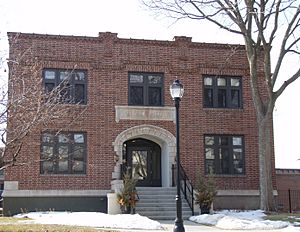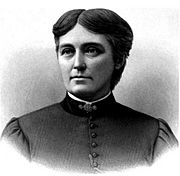Martha Ripley facts for kids
Martha Ripley (born November 30, 1843 – died April 18, 1912) was an American doctor, a champion for women's right to vote (a suffragist), and a medical teacher. She started the Maternity Hospital in Minneapolis, Minnesota. Martha Ripley was a strong voice for women who needed help. She was a key leader in the American Woman Suffrage Association. She also led the Minnesota Woman Suffrage Association for six years.
Contents
Martha Ripley's Early Life
Martha George Rogers was born on November 30, 1843, in Lowell, Vermont. She was the oldest of five children. Her parents were Esther Ann and Francis Rogers, who was a farmer. Her family later moved to Iowa. Martha went to high school there, but she didn't finish with a diploma.
She earned a top teaching certificate. For a while, she taught at an elementary school. In 1867, she married William Warren Ripley. He was a rancher from a well-known family in Massachusetts. Soon after, they moved to Massachusetts. William managed his uncle's paper mill there. The couple had three daughters: Abigail, Clara, and Edna May. A few years later, William bought his own mill. The family then moved to Middleton.
Joining the Suffrage Movement
Martha Ripley joined the suffragists in 1875. These were people who worked for women's right to vote. She helped create an active suffrage group in Middleton. She became good friends with Boston suffragettes Lucy Stone and Henry Browne Blackwell. Her hard work made her well-known in the statewide suffrage movement.
She was chosen for both the central and executive committees of the Massachusetts Woman Suffrage Association. She served in these roles until 1883. Martha Ripley was known as an excellent public speaker. She often spoke her mind. Many professional women and doctors liked and respected her.
Becoming a Doctor and Public Health Work
Martha Ripley was worried about the health of women working in textile mills in Massachusetts. This concern led her to go to medical school. In 1880, Ripley enrolled at Boston University Medical School. She earned her M.D. degree in 1883. She studied Homeopathy, which was a different medical approach than the male-dominated Allopathic medicine.
That same year, her husband was badly hurt in a mill accident. He had to stop working. Now, the family depended on Martha to earn money. They moved to Minneapolis, Minnesota. William had relatives there. The growing industries in Minneapolis offered new chances for people.

Starting a Medical Practice
It was hard for Ripley to start her medical practice in Minneapolis. But she became a successful doctor, specializing in childbirth. She got her license to practice in 1883. This made her one of the first two dozen licensed women doctors in Minnesota. In the same year, Ripley was elected president of the Minnesota Woman Suffrage Association.
Because of her many connections, she helped bring the national meeting of the American Woman Suffrage Association to Minneapolis in 1885. At one point, Ripley even personally asked the state senate to give women the right to vote.
Advocating for Public Health
During her six years as president, she often spoke about public health. She talked about city sanitation, clean water, and safe food. She also spoke about hospitals being too crowded. Ripley also pushed for more women police officers. She wanted women to be involved in city decisions. She was an early supporter of cremation. She believed it was better for public health and cost less for poor people. After her presidency, Ripley stayed involved for six more years. She was a member of the association's medical board.
Founding Maternity Hospital
Like other women doctors then, Ripley found that most of her patients were women and young children. They often had trouble getting hospital care. For example, no hospitals in Minneapolis at that time would admit a pregnant woman who was not married. Ripley was inspired to start a new hospital. It would be run by and for women, especially those who were struggling financially.
Her Maternity Hospital was officially started in 1887. It was later renamed Ripley Memorial Hospital. It stayed open until 1957. It closed because it had few patients and money problems. The hospital started in 1886, just three years after Ripley became a doctor. It quickly grew to a twenty-room facility. Its goal was to provide a safe place for childbirth. This was for married women who couldn't afford good care. It also helped young women who needed support during pregnancy.
In 1896, the hospital moved to Western and Penn Avenue North. It became known for having the lowest maternal death rates in the area. It was also the first Minneapolis hospital to create a social service department.
Later Activism and Legacy
Through Ripley's efforts, the hospital and her advocacy helped strengthen the suffragette movement in Minnesota. Leaders like Frances Willard and Carrie Chapman Catt often visited Ripley. Her activism was well-known and respected, though sometimes people made fun of it. Ripley was also nominated to be a director of public schools. However, she was not elected because women were not allowed to hold that position. Ripley also taught about children's diseases at the Homeopathic Medical College in Minnesota. She was active in the Women's Rescue League.
On April 18, 1912, Dr. Martha George Ripley died. She had problems from a lung infection and rheumatic heart disease. As she wished, she was cremated. In 1939, a plaque honoring her was placed in the rotunda of the Minnesota state capitol building. It recognized her as a pioneering woman doctor and hospital founder.
When Maternity Hospital closed in 1957, the building was sold. The money was used to create the Ripley Memorial Foundation. In 2007, the hospital building was turned into apartments. It was renamed Ripley Gardens. This project was partly funded by the National Trust for Historic Preservation. Her ashes were eventually placed in the cornerstone of this building. A book written before her death, History of the City of Minneapolis, Minnesota, said she "has proven herself friend of the friendless, the consoler of the sorrowing, the wise counselor and efficient helper of the unfortunate."
See also
 In Spanish: Martha Ripley para niños
In Spanish: Martha Ripley para niños


